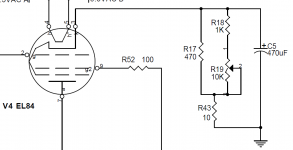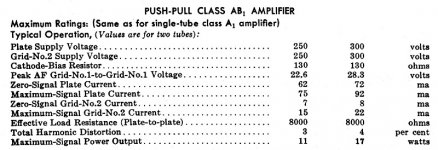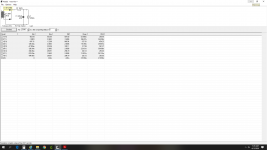OK, again you are following the schematic which is nothing like the PCB. The PCB has a spot for the 47uF cap, 2 6.8K resistors, 1/channel, and 2 22uF caps, 1/channel. I ask again, how were you fully planning to build this out?
I assumed he meant following the schematic on that ebay page, where they use a CRC filter 220uF, 100 ohm, 220uF for B+. This filter needs some adjustment to get lower B+ with his 300-0-300V transformer.
(I thought it was obvious. Maybe not)
Last edited:
BJ: you can make a fime amp with the trannies you have
The Tubelab is a cathode bias amp. I stole a trick from the no longer available DIYtube Dynaclone and made the cathode bias adjustable. Look through the links in my previous post, you'll find a schematic or the Tubelab SPP there. It's also on the Tubelab forum but it takes some digging.
If you build the stock Tubelab SPP it runs the EL84s a bit hard. The Russian tubes can usually handle this. The JJs have a lower dissipation so you should increase the cathode resistor. It's covered in the parts lists connected to the WOS articles.
The newer Hammond power trannies have a 125 volt tap on the primary that helps keep the secondary voltage a bit lower. Use a CL-90 inrush limiter you'll loose a couple of volts this way. A small value WW resistor in the pri circuit might be helpful.
Steve
The Tubelab is a cathode bias amp. I stole a trick from the no longer available DIYtube Dynaclone and made the cathode bias adjustable. Look through the links in my previous post, you'll find a schematic or the Tubelab SPP there. It's also on the Tubelab forum but it takes some digging.
If you build the stock Tubelab SPP it runs the EL84s a bit hard. The Russian tubes can usually handle this. The JJs have a lower dissipation so you should increase the cathode resistor. It's covered in the parts lists connected to the WOS articles.
The newer Hammond power trannies have a 125 volt tap on the primary that helps keep the secondary voltage a bit lower. Use a CL-90 inrush limiter you'll loose a couple of volts this way. A small value WW resistor in the pri circuit might be helpful.
Steve
I assumed he meant following the schematic on that ebay page, where they use a CRC filter 220uF, 100 ohm, 220uF for B+. This filter needs some adjustment to get lower B+ with his 300-0-300V transformer.
(I thought it was obvious. Maybe not)
The eBay page is confusing. Neither the schematic they post is right , NOR the markings on the PCB in the pics (lost in translation I guess) it is CRC 220uf, 6.8k, 220uf.
You are only running the simulation for a fraction of a second, or 1 millisecond. Run it at least 5000 ms.
And you can't have that many 6k8 resistors for B+. You end up with no voltage at all. The main B+ in circuits such as this one have two RC filters with 100 ohm 10W resistors. The 6k8 resistor is for the lower voltage to the 12AX7 in the input/phase splitter.
Got it. Thank you, I see what I did wrong, I'll redo that model.
I'll toot my own horn, others toot theirs. Here's the complete build series I did for beginners on the Wall of Sound.ca site.
Steve, you are right to toot the horn! Nice, well-written articles that I enjoyed reading. A little off OP perhaps, but I’m interested to know how you concluded (what setup, listening methods, etc, etc) the Tubelab SPP sounds better than the diyTube ST35 clone. The SPP is simple indeed (in a good way). Next you need a shoot-out against a Baby Huey.
The Dynaco Z565's on the Triode website went up in price since I bought them for my amp in 2006.
But are still IMO the best UL iron for a pair of EL84's.
But are still IMO the best UL iron for a pair of EL84's.
And your R3 should simulate the full load of two EL84 + the smaller current to the 12AX7, so put something like a 220 mA current sink instead as suggested in the schematic (I don't know exactly how much that circuit needs).
Ok so I looked in the RCA receiving tube manual and it says for PP Class AB1 6BQ5 at 300V plate supply the maximum-signal plate current is 92ma (for 2 tubes)
Ok so I looked in the RCA receiving tube manual and it says for PP Class AB1 6BQ5 at 300V plate supply the maximum-signal plate current is 92ma (for 2 tubes)
46mA through an EL84 is going to dangerous turf.
Tube life would suffer greatly.
I run my EL84's with a comfortable 26mA @300V and enjoy much longer tube life.
46mA through an EL84 is going to dangerous turf.
Tube life would suffer greatly.
I run my EL84's with a comfortable 26mA @300V and enjoy much longer tube life.
46mA is Maximum-Signal Plate Curent
36mA (72mA for 2 tubes) is Zero-Signal Plate Curent - plate dissipation 10.5W
Attachments
Wise old: At 300 volts you could probably turn up the wick a bit to 35mA, still have decent tube like and probably get better sound. Tubes running cool always sound a bit cool to me.
Francois: The shoot-out between two SPPs (system details too) with different trannies is is here:
EL84 DIY Amp Project, Part 6 (Conclusion): Sonic Evaluation and Output Mode Options | Wall of Sound | Audio and Music Reviews
Francois: The shoot-out between two SPPs (system details too) with different trannies is is here:
EL84 DIY Amp Project, Part 6 (Conclusion): Sonic Evaluation and Output Mode Options | Wall of Sound | Audio and Music Reviews
46mA is Maximum-Signal Plate Curent
36mA (72mA for 2 tubes) is Zero-Signal Plate Curent - plate dissipation 10.5W
Yes, I already know that. 😉
Wise old: At 300 volts you could probably turn up the wick a bit to 35mA, still have decent tube life and probably get better sound. Tubes running cool always sound a bit cool to me.
Oh, please, enough with that "cool" stuff.
How on earth did that bunch of babble ever get started? (probably the internet)
I've already seen the guitar/musician websites where they become master geeks and discuss modifying their amps, and talk that hot-cool stuff.
Musicians should stick to making music, and keep their paws out of attempting to be wannabe super techs.
Leave the servicing to the educated service techs who know proper repairs.
As far as that biasing of tubes, it largely determines tube life, running them "hot" as you say doesn't produce better sound. (just as audiofools think fancy interconnecting wires think they sound better)
I ought to know, I've been making, and servicng, tube amps for decades now.
As for the 26mA/per tube that I previously mentioned, that was suggested by David Gillespie, (also a member here) a highly regarded individual that has produced some very good work regarding tubes and solid state equipment.
His documented results show substantially better resulting performance, as does my own findings - scope readings, THD, etc., all amount to vastly improved sonics.
Adhering to well within "design ratings" for a specific tube is my preference, not pushing the limits because someone said it's better.
Last edited:
Wise:
I'm not questioning your experience with biasing but mine runs just the opposite. Running at 60% or less dissipation doesn't sound as good to me (I've tried this with many different power tubes) as running them at high sixties into the low seventy percent range. Life is too short to save a few tube hours and not have the best sound IMHO.
I've run JJ EL84s at 35mA and 300 volts and gotten years of service out of them.
Cheers, Steve
I'm not questioning your experience with biasing but mine runs just the opposite. Running at 60% or less dissipation doesn't sound as good to me (I've tried this with many different power tubes) as running them at high sixties into the low seventy percent range. Life is too short to save a few tube hours and not have the best sound IMHO.
I've run JJ EL84s at 35mA and 300 volts and gotten years of service out of them.
Cheers, Steve
.....
Francois: The shoot-out between two SPPs (system details too) with different trannies is is here: EL84 DIY Amp Project, Part 6 (Conclusion): Sonic Evaluation and Output Mode Options | Wall of Sound | Audio and Music Reviews
Thanks for the link. I very much enjoyed reading the review of the different transformered versions of the SPP, as well as the earlier comparison of the Finalé F-7189 II and the diyAudio ST35 clone. The reviewer’s statement that the SPP sounds better than the ST35 clone intrigues me. I’m not quite convinced yet.
I have to point out that said ST 35 clone, according to the author was built using prosaic parts compared to expensive Mundorf caps etc. in the Finalé, that costs C$3800. Also interesting is the fact that that the Finalé produces 20watts in pentode mode, vs the 15w in UL of the ST35 clone. Where the Baby Huey will fit in remains to be seen. I have high expectations of it.
Last edited:
Got it. Thank you, I see what I did wrong, I'll redo that model.
Ok I think this works better
Attachments
Wise:
I'm not questioning your experience with biasing but mine runs just the opposite. Running at 60% or less dissipation doesn't sound as good to me (I've tried this with many different power tubes) as running them at high sixties into the low seventy percent range. Life is too short to save a few tube hours and not have the best sound IMHO.
I've run JJ EL84s at 35mA and 300 volts and gotten years of service out of them.
Cheers, Steve
I don't care for the JJ brand EL84's.
I've had issues with them in my one amp running at 26mA - lightly used I might add.
They don't hold specification as well as other brands.
In fact, I recently replaced the set I had, one being totally dead - zero emission, after a couple of years of occasional use. (I mainly use a solid state Technics amp)
Granted, it was one dead tube out of 4, but the others were all over the map in emission too.
The best set I have is in a console stereo in the dining room.
An RCA Victor set from 1963, customized by me, running a set of Radio Shack "gold pins" Lifetime 7189A's - which still read great after decades of use.
I run them well under design specs, (300V) and yet they sound fantastic.
Wise:
..... Life is too short .....
Cheers, Steve
I first became interested in hi-fi audio in high school in the early 1990's. AS with probably a lot of kids, it started with building speaker enclosures in shop class, getting the Loudspeaker Cookbook and debating BR vs AS with my friends. It was also then I first bought my first few issues of Glass Audio and a book about building a Williamson amplifier.
Later, around 1998 I was out of college and had a job and was able to afford things like tubes and transformers. I was able to build a JE Labs Simple 45 and also lay the plans (and buy parts) to build some kind of PP EL84 and a SE 6550. And then life happened.
Occasionally over the years I might make a little progress here or there, moving the Simple 45 from a breadboard layout into a Hammond 1444 case or making a quick something to scratch the hifi itch (I did some JLH 1969's recently). But all the while carrying those parts around in cardboard boxes. Sometimes having to replace the BOX because it wears out!
Ironically, as I compare searching for parts between now and then there seems to be MORE tube choices available. Like I said I ordered the JJ EL84s because that was about all there was for new inexpensive tubes back then, but a quick look at Tube Depot shows ALOT more choices!
So I now have time to return to working on some of this and just want to put all those parts to use, so they don't set in a box for another 20 years. I know this isn't the most optimal design, I just want it to work the best IT can for what IT is. Perfect is the enemy of good...
Francois,
I was surprised at the differences between the two SPPs. Granted the one with the Hammonds has Mundorfs but the other with the old Heathkit trannies has decent Cornell Dublier 940C caps coupling the phase splitters to the EL84s. Other than these caps and the trannies the amps are very similar. I think the sonic differences are mostly down to the output trannies.
I've been thinking for some time that the amp using the old Dynaco transformers could use a cap upgrade. It was built with generic film caps from Mouser. Reviewing the circuit I could likely ditch the input coupling cap too.
Another poster mentioned that replacement Dynaco OPTs from Triode Electronics being the preferred choice. The problem is that their price, times about $1.40 CDN to buy a US dollar, plus shipping makes them especially pricey if shipped out of the US. Hammonds are a decent enough go-to for us Canuks.
Cheers, Steve
I was surprised at the differences between the two SPPs. Granted the one with the Hammonds has Mundorfs but the other with the old Heathkit trannies has decent Cornell Dublier 940C caps coupling the phase splitters to the EL84s. Other than these caps and the trannies the amps are very similar. I think the sonic differences are mostly down to the output trannies.
I've been thinking for some time that the amp using the old Dynaco transformers could use a cap upgrade. It was built with generic film caps from Mouser. Reviewing the circuit I could likely ditch the input coupling cap too.
Another poster mentioned that replacement Dynaco OPTs from Triode Electronics being the preferred choice. The problem is that their price, times about $1.40 CDN to buy a US dollar, plus shipping makes them especially pricey if shipped out of the US. Hammonds are a decent enough go-to for us Canuks.
Cheers, Steve
Francois,
I was surprised at the differences between the two SPPs. Granted the one with the Hammonds has Mundorfs but the other with the old Heathkit trannies has decent Cornell Dublier 940C caps coupling the phase splitters to the EL84s. Other than these caps and the trannies the amps are very similar. I think the sonic differences are mostly down to the output trannies.
I've been thinking for some time that the amp using the old Dynaco transformers could use a cap upgrade. It was built with generic film caps from Mouser. Reviewing the circuit I could likely ditch the input coupling cap too.
Another poster mentioned that replacement Dynaco OPTs from Triode Electronics being the preferred choice. The problem is that their price, times about $1.40 CDN to buy a US dollar, plus shipping makes them especially pricey if shipped out of the US. Hammonds are a decent enough go-to for us Canuks.
Cheers, Steve
This is all very interesting! I would love to get your reaction once the “old Dynaco” SPP had its upgrade. In my experience the Hammonds are decent transformers but I would not be surprised if the Dynaco A-410s are the better transformers (although they were only $14.95 in the heyday!).
I got some 8k UL toroids from Toroidy, made in Poland, via TME.com at a very good price, shipped to the US for ~US$70 each. They are rated for 40VA output, so they are substantial. I have not heard them yet but plan to use them in my Baby Huey. Other BH builders liked what they heard via the Toroidy trannies and one of your compatriots measured the 6.6k Toroidy flat out to >200k Hz.
- Home
- Amplifiers
- Tubes / Valves
- PP EL84


